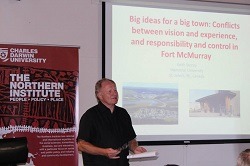Fly-in/Fly-out: Community tensions and planning approaches in Canada and Australia

Honorary Research Professor Keith Storey recently visited Darwin, NT and several communities in Western Australia (WA) as part of his ongoing research into the implications and management of commute work in the resource and construction sectors. While there he gave public presentations at Charles Darwin University in Darwin, the Curtin Graduate School of Business in Perth and the Pam Buchanan Family Centre in Karratha.
Commonly referred to as Fly-in/fly-out or FIFO, commute work arrangements offer both challenges and opportunities to the boomtown communities that host projects that rely on FIFO workers. Host communities perceive that transient FIFO workers contribute little or nothing towards local infrastructure and service costs, or to long-term community development. Attracting production workers to become full-time residents is a primary objective in such communities in both Canada (e.g. Fort McMurray, AB) and WA’ s Pilbara region (e.g. Karratha and Port Hedland).
Investment in housing, infrastructure and services has not kept pace with demand, and lack of affordable housing, schools, retail infrastructure and other urban amenities are among the disincentives for workers and families to relocate to these relatively remote communities. That said the Royalties for Regions program recently introduced in WA, has significantly improved the livability of some of the State’s more remote communities. There is no comparable investment program in Canada. However, both in the Pilbara and Fort McMurray, the continued growth in FIFO and turnover in residential populations continues to limit the realization of local aspirations for community stability and long-term development.
While affordability is a major constraint to worker and family relocation decisions, place preferences are also extremely important. As such FIFO remains the preferred work arrangement for many, with workers commuting and families remaining in their home locations. Community plans that envision a future where the workforce is mainly residential and use of FIFO is minimal, may not be realistic given today’s labour market conditions in which skilled workers are in short supply and where wages and paid transportation allow workers to exercise their preferences to live elsewhere. Recognizing that both residential and FIFO choices need to be available to attract a workforce, and optimizing the outcomes of these inherently conflicting arrangements, remains an ongoing challenge for resource communities in both Canada and Australia.